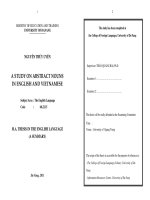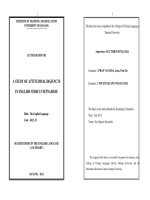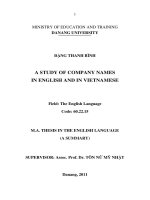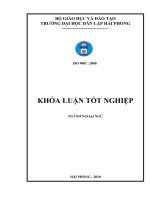A study on conditional sentences in english and vietnamese
Bạn đang xem bản rút gọn của tài liệu. Xem và tải ngay bản đầy đủ của tài liệu tại đây (412.11 KB, 71 trang )
BỘ GIÁO DỤC VÀ ĐÀO TẠO
TRƯỜNG ĐẠI HỌC DÂN LẬP HẢI PHỊNG
-------------------------------
ISO 9001 : 2008
KHĨA LUẬN TỐT NGHIỆP
NGÀNH NGOẠI NGỮ
HẢI PHÒNG - 2010
HAIPHONG PRIVATE UNIVESITY
FOREIGN LANGUAGES DEPARTMENT
-----------------------------------
ISO 9001 : 2008
GRADUATION PAFER
THE STUDY ON CONDITIONAL SENTENCES IN
ENGLISH AND VIETNAMESE
By:
Le Thi Yen
Class:
NA1004
Supervisor:
Nguyen Thi Thu Huong
HAI PHONG - 2010
1
BỘ GIÁO DỤC VÀ ĐÀO TẠO
TRƯỜNG ĐẠI HỌC DÂN LẬP HẢI PHÒNG
--------------------------------------
Nhiệm vụ đề tài tốt nghiệp
Sinh viên: ............................................................Mãsố: ............................
Lớp: .............................Ngành:....................................................................
Tên đề tài: .................................................................................................
..................................................................................................
................................................................................................
..................................................................................................
2
Nhiệm vụ đề tài
1. Nội dung và các yêu cầu cần giải quyết trong nhiệm vụ đề tài tốt
nghiệp
(về lý luận, thực tiễn, các số liệu cần tính tốn và các bản vẽ).
……………………………………………………………………………..
……………………………………………………………………………..
……………………………………………………………………………..
……………………………………………………………………………..
……………………………………………………………………………..
……………………………………………………………………………..
……………………………………………………………………………..
……………………………………………………………………………..
2. Các số liệu cần thiết để thiết kế, tính tốn.
……………………………………………………………………………..
……………………………………………………………………………..
……………………………………………………………………………..
……………………………………………………………………………..
……………………………………………………………………………..
……………………………………………………………………………..
……………………………………………………………………………..
……………………………………………………………………………..
……………………………………………………………………………..
3. Địa điểm thực tập tốt nghiệp.
……………………………………………………………………………..
……………………………………………………………………………..
……………………………………………………………………………..
3
CÁN BỘ HƯỚNG DẪN ĐỀ TÀI
Người hướng dẫn thứ nhất:
Họ và tên: .............................................................................................
Học hàm, học vị: ...................................................................................
Cơ quan công tác:.................................................................................
Nội dung hướng dẫn:............................................................................
Người hướng dẫn thứ hai:
Họ và tên:.............................................................................................
Học hàm, học vị:...................................................................................
Cơ quan công tác:.................................................................................
Nội dung hướng dẫn:............................................................................
Đề tài tốt nghiệp được giao ngày 12 tháng 04 năm 2010
Yêu cầu phải hoàn thành xong trước ngày 10 tháng 07 năm 2010
Đã nhận nhiệm vụ ĐTTN
Đã giao nhiệm vụ ĐTTN
Người hướng dẫn
Sinh viên
Hải Phòng, ngày tháng năm 2010
HIỆU TRƯỞNG
GS.TS.NGƯT Trần Hữu Nghị
4
PHẦN NHẬN XÉT TÓM TẮT CỦA CÁN BỘ HƯỚNG DẪN
1. Tinh thần thái độ của sinh viên trong quá trình làm đề tài tốt
nghiệp:
……………………………………………………………………………..
……………………………………………………………………………..
……………………………………………………………………………..
……………………………………………………………………………..
……………………………………………………………………………..
……………………………………………………………………………..
……………………………………………………………………………..
……………………………………………………………………………..
2. Đánh giá chất lượng của khóa luận (so với nội dung yêu cầu đã đề ra
trong nhiệm vụ Đ.T. T.N trên các mặt lý luận, thực tiễn, tính tốn số
liệu…):
……………………………………………………………………………..
……………………………………………………………………………..
……………………………………………………………………………..
……………………………………………………………………………..
……………………………………………………………………………..
……………………………………………………………………………..
……………………………………………………………………………..
……………………………………………………………………………..
……………………………………………………………………………..
3. Cho điểm của cán bộ hướng dẫn (ghi bằng cả số và chữ):
……………………………………………………………………………..
……………………………………………………………………………..
……………………………………………………………………………..
Hải Phòng, ngày ….. tháng ..… năm 2010
Cán bộ hướng dẫn
(họ tên và chữ ký)
5
NHẬN XÉT ĐÁNH GIÁ
CỦA NGƯỜI CHẤM PHẢN BIỆN ĐỀ TÀI TỐT NGHIỆP
1. Đánh giá chất lượng đề tài tốt nghiệp về các mặt thu thập và phân tích tài
liệu, số liệu ban đầu, giá trị lí luận và thực tiễn của đề tài.
2. Cho điểm của người chấm phản biện :
(Điểm ghi bằng số và chữ)
Ngày.......... tháng......... năm 2010
Người chấm phản biện
6
ACKNOWLEDGEMENTS
First and foremost, my deepest thanks are due to my supervisor Ms. Nguyen
Thi Thu Huong for her invaluable advice, generous assistance and continual
encouragement in completion of this study.
I would like to express my thankfulness to all of the teachers of Foreign
Languages Department - Hai Phong Private University for their help, concern
and support during the time I am studying.
I would also like to send my thanks to all my classmates of NA1004 for these
good ideas and helpful assistance.
Last but not least, I would like to express my heartfelt gratitude to my family
members who have constantly supported, inspired and encouraged me to
complete the graduation paper.
Hai Phong, june 2010
Le Thi Yen
7
TABLE OF CONTENT
Acknowledgements
PART I: INTRODUCTION
1. Rationales
2. Aims of the study
3. Scope of the study
4. Method of the study
5. Design of the study
PART II: DEVELOPMENT
CHAPTER I: THEORETICAL BACKGROUND
1.1. Definition of English sentence
1.2. Types of English sentence
1.2.1: Simple sentence
1.2.2: Compound sentence
1.2.3: complex sentence
1.2.4: Compound-complex sentence
1.3. Mood
1.3.1. Concept of Mood
1.3.2. Types of Mood
1.3.2.1. Indicative Mood
1.3.2.2. Imperative Mood
1.3.2.3. Subjunctive Mood
CHAPTER II: CONDITIONAL SENTENCE IN ENGLISH
2.1. Definition of English conditional sentence
8
2.2. A semantic Overview of Conditional Sentences
2.2.1. Factual Conditional Sentences
2.2.2. Future(or predictive) Conditional Sentences
2.2.3. Hypothetical Conditional Sentences
2.3.A syntactic Analysis of Conditional Sentences
2.3.2. Subordinating Conjunctions in Conditional Sentences
2.3.3. Subject/ auxiliary Inversion in Conditionals
2.3.4. Conditional Clause Pro-form
2.3.5. Ordering of Clauses in Conditional Sentences
2.4.Classification of Conditional Sentences
2.4.2. Types 1-Real Conditional Sentences or Open Conditional
Sentence
2.4.2.1. General Present
2.4.2.2. General Past
2.4.2.3. Future
2.4.3. Types 2-Unreal Conditional Sentences or Hypothetical Condition
2.4.3.1. Hypothetical Conditional referring to the Present or
Future Time
2.4.2.1.1. Hypothetical Conditional referring to Future Time
2.4.2.1.2. Hypothetical Conditional referring to Present Time
2.4.3.2. Hypothetical Conditional referring to Past Time
2.4.3.2.1. Unfulfilled Past Condition
2.4.3.2.2. Unknown Past Condition
2.5. Related Forms
9
CHAPTER III: THE CONDITIONAL SENTENCES IN ENGLISH
THROUGH CONTRASTIVE ANALYSIS WITH VIETNEMESE
3.1. The Vietnamese conditional sentences
3.2. The comparison between English and Vietnamese Conditional Sentences
3.2.1. The similarities between English and Vietnamese conditional
sentences
3.2.2. The differences between English and Vietnamese conditional
sentences
CHAPTER IV: COMMON MISTAKES MADE BY VIETNEMESE
LEARNERS IN USING ENGLISH CONDITIONAL SENTENCES AND
SUGGESTED SOLUTIONS
4.1. Common mistakes made by Vietnamese learners
4.2. Suggested solutions
PART III: CONCLUSION
REFERENCES
APPENDIX
10
PART I: INTRODUCTION
1. Rationales
Nowadays, English has been spoken all over the world as an
international language. No one can deny that English plays an important role
in social life. It is widely used in every field of life such as science,
technology, foreign trade, tourism, business, education and so on. In Vietnam,
it is now a great demand to learn English for the process of integrating into
regional and international economic and diplomatic development. Moreover,
English enables us to communicate with people from different countries and
understand more about their tradition and culture. However, it is not easy to
learn English as the second language for Vietnamese because there are a lot of
differences between two languages and grammar is the typical problem for this.
In term of English grammar, from my point of view, English
conditional Sentence is the most difficult problem for Vietnamese, there are
some reasons:
- Conditional Sentences in English consists of two clauses and the
structures of each clause are very complicated.
- There are a lot conditional sentences which make both English and
Vietnamese easily confuse in using.
- Great differences appear between English and Vietnamese conditional
sentences.
For all their reasons above, I have chosen “The study on Conditional
Sentences in English and Vietnamese”. For my study, with the hope that it
will be the useful references for both teachers of English and learners
especially Vietnamese learners.
2. Aims of study
The study on conditional sentences in English and Vietnamese aims at:
* Giving the definition of English conditional sentences and its semantic, syntactic
functions (its structures and uses)
11
* Describing and clarifying different types of English conditional sentences.
* Identifying common mistakes made by Vietnamese learners
* Suggesting solutions to overcome these mistakes
3. Scope of the study
Firstly, conditionals in English are very complicated problem so
presenting a full theory and description of it is impossible for me. Therefore,
my graduation paper will focus mainly on describing and analyzing the most
common structures and uses of natural language conditional sentences.
Secondly, more attention will be paid to the theory, description and
classification of English conditional sentences than to Vietnamese conditional
sentences which make my graduation paper more helpful and more practical
for the learner of English
Lastly, because of the limitation of time, making a through and detailed
comparison between English and Vietnamese conditional sentence, I shall
only bring out the most striking differences between the two languages to help
those interested to avoid possible deplorable mistakes in using this particular
kind of sentence structure.
4. Method of the study
My strategies for completion of the graduation paper include:
- With references collected from different sources inside and outside
university, I review the documents relating to English and Vietnamese
conditional sentences
- To complete this study, I collect materials, references to analyze and find
out the similarities and differences of the conditional sentences between the
two languages.
- Analyze the students‟ problems in using English conditional sentences
based 4 years being a student at HPU. Therefore, I give suggested solutions.
12
5. Design of the study
This study consists of three main parts:
Part one is the introduction giving out the reasons for choosing the
topic of this graduation paper, pointing out the aims, the methods and the
design of the study.
Part two consists of 4 chapters:
Chapter 1 gives the theoretical back ground, presents the definition,
structures and types of English conditional sentence.
Chapter 2: Clarifies the definition of English conditional sentences and
analyses its semantic and syntactic functions, then, clarifies the types
including real and unreal conditional sentences.
Chapter 3 refers to the conditional sentences in English through
contrastive analysis with Vietnamese.
Chapter 4 provides common mistake made by Vietnamese learners when
using conditional sentences and suggests some helpful solutions.
Part three is the conclusion presenting the review of the study and the
references will put the end of the graduation paper.
13
PART II: DEVELOPMENT
CHAPTER I: THEORETICAL BACKGROUND
1.1. Definition of English sentence
We have used sentences all our life to communicate our ideas in
writing or in speech. However, we may not have paid close attention to how
sentences are correctly and effectively written. There are different ways to
define a sentence but we would prefer a traditional grammar-based definition.
There are many authors giving different definitions about English
sentence. According to English-Vietnamese dictionary published in 1999 of
Da Nang publisher, a sentence is defined as “a series of words making a
single complete statement.”
For example: He is a doctor.
This example is considered a sentence because of two reasons. Firstly,
it is a complete statement “he (a person that both the speaker and the hearer
already know) has a job of a doctor, which is expressed by using to be “is”.
By this way, the new information “being a doctor” - a complete statement - is
transferred. Secondly, “ he is a doctor” is the combination of a series of words
“he, is, a, doctor”.
However, the definition is not totally true because it does not give the
ways to combine words to make a sentence. Moreover, “single complete
statement” is only phrase used for simple sentence, not for other kinds of
sentences. It should be “a complete thought”.
Another idea of sentence structure comes from Alice Oshima & Ann
Hogue.
They stated:
“The subject is the word or words that name the person, thing, or place
that a sentence is about. It is usually a noun or pronoun.”
14
“The predicate makes a statement about the subject. It consists of a
verb and its modifiers or complements. The verb is the most important point
of the predicate-it express action or a state of being.”
(OSHIMA, A& HOGUE, A; 2003, writing Academic English; 121)
Normally, the subject of the sentence, in a word order of a statement,
stands before its verb predicate. However, the order of the sentence can vary
according to the types of sentence (statement, question, request, etc.).
Moreover, sentence structure, in concentrating on the elements (subject, verb,
direct
object,
indirect
object,
adverb,
subject
complement,
object
complement) which are used form a sentence.
Then a more practical definition of sentence was given: “A sentence is
a word or group of words standing between an initial capital letter and a
mark of end punctuation or between two marks of end punctuation”. However
students still find it difficult to put right punctuation in the writing because
they marked with capital letters at the beginning and full stops at the end are
“sentences in that they do not contain a thought. Once again, this definition
does not help us to understand what a sentence is.
From these definitions above, many authors have reviewed the former
definitions and attempted to state the essential features of the sentence.
Quirk (1971): “A sentence is a group of words containing a subject and
a finite verb (other parts if necessary) expressing a statement, a question, an
explanation or a command.”
John Ries (1931): “ A sentence is a grammatically constructed smallest
unit of speech which expresses its content with respect to this content‟s
relation to reality”.
In short, all these definition have not given us a satisfactorily
acceptable or workable set of criteria to make a complete definition. Anyway,
they can help each of us have a general idea of what a sentence is.
15
1.2. Types of English sentence:
There are basically four kinds of sentence in English consisting of
simple sentence, compound sentence, complex sentence and compoundcomplex sentence
1.2.1. Simple sentence
A simple sentence is the one that consist of one independent clause.
According to Quirk (1976), sentence can be classified into 7 types:
SV: The child laughed.
SVA: Mary is in the house.
SVC: Mary is a nurse.
SVO: Somebody caught the ball.
SVOA: I put the plate on the table.
SVOC: We have proved him a fool.
SVOO: She gives me expensive present
1.2.2 Compound sentence
Most of textbooks (ESL, EFL..) gave a definition about compound
sentence as follows: A compound sentence contains at least two independent
clauses, often joined by a coordinating conjunction.
The coordinating conjunctions are as follows: but, and, nor, either, so,
not only, but also… Except for very short sentences, coordinating
conjunctions are always preceded by a comma.
A. I tried to speak Spanish, and my friend tried to speak English.
B. I played badminton, so you went shopping.
C. I played badminton, for Thuy went shopping.
The above three sentences are compound sentences. Each sentence
contains two independent clauses, and they are joined by a coordinator with a
comma preceding it.
16
1.2.3. Complex Sentence
Complex sentence which contains more than one clauses of which one
is the main clause, the others are subordinate clauses being part of the main
clause. The subordinate clauses and main clause are jointed together by
subordinating conjunctions.
The main clause is a clause which has a meaningful unit by a independent
clause but it also needs one or more subordinate clause complementing for it.
The subordinate clause (dependent clause) is a clause which has to depend
on the main clause.
-There are many subordinate clauses:
+Subordinate clause has a function as a noun (noun clause).
I don‟t know / when she will come.
Main clause
noun clause
+subordinate clause has a function as a adjective (adjective clause).
This is the magazine / which you ordered.
Main clause
adjective clause
+subordinate clause has a function as adverb (adverbial clause)
Adverbial clause show when, where, how, why the action in the main
clause occurring. So, adverbial clause is named basing on function of it:
-Adverbial clause of time shows when the action in the main clause occurring.
Shut the door / when you leave.
Adverbial clause of time
-Adverbial clause of reason shows why the action in the main clause
occurring.
He couldn‟t joint the trip / because he was rich.
Adverbial clause of reason
-Adverbial clause of condition shows how the action in the main clause
occurring.
The sun‟s activities were not so steady / life on the earth would soon cease.
Adverbial of condition
17
1.2.4 Compound-complex sentence
The compound-complex sentence seems to be a complicate sentence in
English grammar. As Oshima and Hogue in “writing academic English”
published in 2003 wrote:
A compound-complex sentence is the combination of two or more
independent clauses and once and more dependent clause.
Example for:
I will come and I will bring some of my friends / if they have a day off.
Compound sentence
adverbial clause of condition
Therefore, the conditional sentence is one kind of complex sentence
because it contains a main clause and subordinate clause (if clause) joined
together by subordinating conjunctions such as if, unless…
1.3 MOOD
1.3.1. Concept of Mood
Some authors have mentioned the concept of mood in their book.
According to E.M.Gordon and I.P.Krylova: “Mood is the form of the
which shows the relation between the action expressed by the predicate verb
and reality”.
This relation is establish by the speaker may wish to present an action as a
real fact or as command (a request) or as something unreal, something that
does not exist in reality”.
V. Vinogradov also expressed the same idea in another way: “Mood
expresses the relation of the action to reality as stated by the speaker”.
Or we can the definition of mood in some dictionaries. For example: The
Webster‟s New world dictionary, Elementary Edition defines mood as: “the
form of the verb that shows whether it is expressing a fact (indicative mood),
a wish or possibility (subjunctive mood), or a command (imperative mood).,
18
1.3.2. Types of Mood
There have been a lot of opinions about the difficult types of mood but the
most common view is that in modern English there are three moods:
Indicative , Imperative mood and subjunctive mood.
1.3.2.1. Indicative Mood
According to llyish (1971), the use of the Indicative Mood shows that the
speakers (or writers) present the action or real. Most of what we have said is
in the indicative mood, most of what anyone says or writes is in the indicative
mood. So, this is the most common mood used in any language. We can use
indicative mood to give information ( E.g. I like reading poetry, we had
dinner at six…), to express opinions (E.g. I think she is a good student,…) to
make promises ( E.g. I shall do every thing I can help you,…)
However, some doubt about meaning of the indicative may arise if we take
into account its use in conditional sentences. For instance, in the sentence “I
will help him if he asks me”, it may be argued that the action denoted by the
verb in the indicative is not represented as a fact but merely as a possibility
but this does not affect the meaning of the grammatical form as such. It is
clear that the condition and the consequence are both real because the verb
forms convey such meaning. Therefore, in indicative mood the predication
need not necessarily be true but the most important thing is that the speaker
represents it as being so.
1.3.2.2. Imperative Mood
The imperative Mood is the plain stem of the verb. It may be used in
the affirmative (E.g. Sit down!) and in the negative form (E.g. Don‟t go out!,
Don‟t be a fool!) If we want to make a command or request more expressive,
we use the emphatic form (E.g. Do listen to him! Do be quiet!...)
We have the following different kinds of command:
- Command without a subject (E.g. Open the door!)
19









